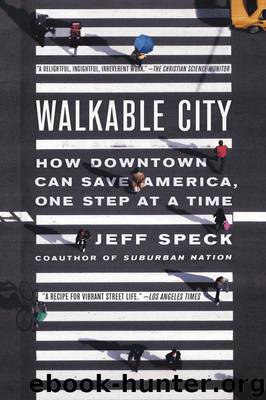0865477728 (N) by Jeff Speck

Author:Jeff Speck
Language: eng
Format: mobi
Publisher: Farrar, Straus and Giroux
Published: 2015-05-09T22:00:00+00:00
THE SAFETY APOTHEOSIS
If greater perceived danger leads to safer driving, how do you make the safest streets in the world? That question was probably best answered by Hans Monderman (1945–2008), the Dutch traffic engineer who pioneered two wonderful and interrelated concepts: naked streets and shared space. While not appropriate everywhere, these techniques have a lot to teach us as we work to improve our cities.
Naked streets refers to the concept of stripping a roadway of its signage—all of it, including stop signs, signals, and even stripes. Far from creating mayhem, this approach appears to have lowered crash rates wherever it has been tried. Following Monderman’s advice, the Danish town of Christiansfeld removed all signs and signals from its main intersection, and watched the number of serious accidents each year fall from three to zero. The British county of Wiltshire, home to Stonehenge, pulled the centerline off a narrow street, and witnessed a 35 percent drop in the number of collisions.11 Drivers passed oncoming cars at a 40 percent greater distance than on a striped street, even though the striped roadway was wider.12
Monderman described his approach this way: “The trouble with traffic engineers is that when there’s a problem with a road, they always try to add something. To my mind, it’s much better to remove things.”13 This makes particular sense in the Netherlands, where there is a tradition of reticent roadways—you are unlikely to see a stop sign there14—but the idea has also spread to Austria, France, Germany, Spain, and Sweden.15
Naked streets are also beginning to appear in the United States, typically in conjunction with Monderman’s other big idea, shared space. In some ways, shared space is simply the extension of the naked streets concept to include the elimination of physical cues and barriers as well, such as curbs and distinct materials for streets and sidewalks. The goal is to create an environment of such utter ambiguity that cars, bicyclists, and pedestrians all come together in one big mixing bowl of humanity.
As David Owen notes, “This sounds to many people like a formula for disaster.” Not so: “The clear experience in the (mainly) European cities that have tried it has been that increasing the ambiguity of urban road spaces actually lowers car speeds, reduces accident rates, and improves the lives of pedestrians.”16 In Monderman’s terms, “Chaos equals cooperation.”17
Monderman was a man with the courage of his convictions. One of his favorite tricks with television reporters was to speak to them while standing in front of a shared-space intersection he had built in the Dutch village of Oosterwolde. Without missing a beat, he would blindly walk backward into the flow of traffic, parting it like the Red Sea.18
America has no shared-space examples as pure as Monderman’s, but one of the first attempts can be found on Espanola Way in Miami Beach—just two blocks from the street that was unnecessarily widened a few pages ago. In good political fashion, the city asked the street’s neighbors to participate in the redesign of one
Download
This site does not store any files on its server. We only index and link to content provided by other sites. Please contact the content providers to delete copyright contents if any and email us, we'll remove relevant links or contents immediately.
| Anthropology | Archaeology |
| Philosophy | Politics & Government |
| Social Sciences | Sociology |
| Women's Studies |
Nudge - Improving Decisions about Health, Wealth, and Happiness by Thaler Sunstein(7615)
iGen by Jean M. Twenge(5366)
The Fire Next Time by James Baldwin(5249)
Adulting by Kelly Williams Brown(4487)
The Hacking of the American Mind by Robert H. Lustig(4318)
The Sports Rules Book by Human Kinetics(4294)
The Ethical Slut by Janet W. Hardy(4173)
Captivate by Vanessa Van Edwards(3796)
Mummy Knew by Lisa James(3634)
In a Sunburned Country by Bill Bryson(3485)
The Worm at the Core by Sheldon Solomon(3435)
Ants Among Elephants by Sujatha Gidla(3417)
The 48 laws of power by Robert Greene & Joost Elffers(3024)
Suicide: A Study in Sociology by Emile Durkheim(2973)
The Slow Fix: Solve Problems, Work Smarter, and Live Better In a World Addicted to Speed by Carl Honore(2947)
Humans of New York by Brandon Stanton(2835)
The Tipping Point by Malcolm Gladwell(2827)
Handbook of Forensic Sociology and Psychology by Stephen J. Morewitz & Mark L. Goldstein(2658)
The Happy Hooker by Xaviera Hollander(2655)
